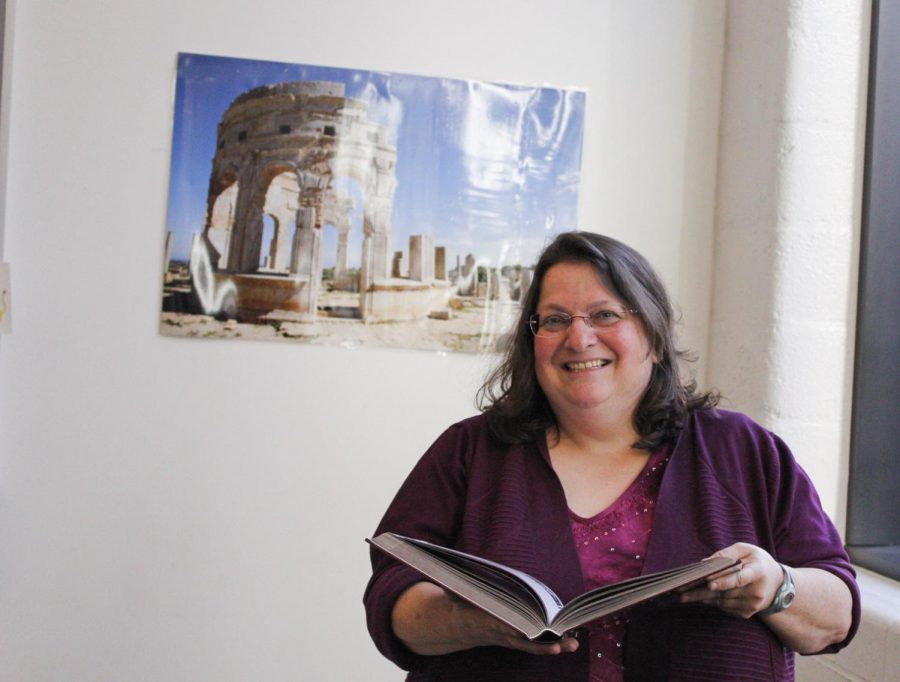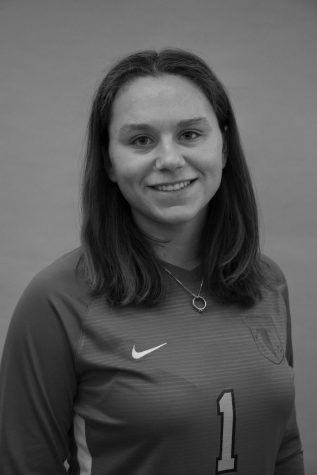Latin Brought to Life at CRLS
Throughout her years as the Latin teacher, Ms. Giacchino has transformed the program.
March 8, 2020
Foreign languages are often the foundation of a modern high school student’s cultural education. Luckily, for high schoolers in Cambridge, access to them is made easy for students at CRLS. The course catalog is full of an unusual range of world languages with expert faculty, including Mandarin, American Sign Language, and Arabic. The Latin program, however, is a largely unknown treasure lying within the halls of the second floor.
An “Undead” Language
The study of Latin in the 21st century benefits students in several ways academically and prolongs the appreciation of ancient culture. Nevertheless, Latin students over the country and around the world are still asked about their choice to study a language with no remaining native speakers. “How’s it going to help you?” people ask, perplexed. “Take something you could actually use, like Spanish.” As the root of all five main Romance languages, however, learning Spanish becomes infinitely easier for a student of Latin.
Taking even just one level of Latin surrounds students with the intricacies of English grammar. Students frequently find their understanding of sentence structure and variety, verb tenses, and the ancient world entirely evolved. The language is everywhere; particularly in commonly used phrases like “et cetera,” “quid pro quo,” “bona fide,” and “per se.” CRLS Latin teacher Maria Giacchino shared with the Register Forum, “A couple of months ago, the words on everyone’s lips were ‘quid pro quo.’ There are phrases in Latin, like how from French we say ‘déjàvu,’ for which we don’t have an English equivalent.”
Junior Alex Kim explained why he chose to take Latin, as opposed to a language widely spoken today: “One of the things I was looking for coming out of middle school was a challenging language, and Latin seemed to be the best fit. Lots of people asked me ‘Where are you going to apply this in the real world?’, but I was just in it for the challenge.”
Students with experience feel that taking the class set themselves up for success in any other academic undertaking they choose to pursue. Senior Olivia Shirley explained, “Latin taught me to study. It taught me how to persevere through a challenging class. While it’s true that I’ll likely never visit a foreign country and need to speak Latin with the locals—unless the Vatican decides to conquer Italy—it’s also true that reading ancient Latin works is incredible.”
Latin has no word order relevant to translation or grammar, and this creates a challenge for students used to English sentences. It takes until Latin 4 and AP Latin for students to read and translate authentic ancient texts, but this was worth the wait for Shirley. “As a Latin student, I was able to read the words that Caesar himself put down thousands of years ago … which gave me an insight into modern governments. I read Vergil’s original work, without having someone else translate it for me; there is nothing like reading text in its original language, in which language it was meant to be read.” Miles Taylor, an alum who graduated in 2018, added his takeaway from Latin at CRLS: “Taking Latin sparked a bit of a linguistics nerd inside of me. We spend a big chunk of time [in Latin class] going over how so many of the words we use in English derive from the vocabulary we learn.”
The Latin Program at CRLS
As many Cantabrigians know, CRLS was broken into two schools before a merger in 1977: The Rindge Technical School and Cambridge High and Latin. Previous to the merger, however, dating back to the 17th century, the Cambridge Latin School, required that students study both Latin and Greek.
400 years later, CRLS currently has only one Latin teacher: Ms. Maria Giacchino. She has a carefully formatted annual schedule which permits her to teach all five levels of Latin, from Latin 1 through AP Latin, over the course of one school year. Ms. Giacchino told the Register Forum, “When I first came here, the Latin program was not an academically rigorous program. I saw Latin as having the potential to be that place where kids who weren’t challenged in other areas could come and find a challenge, and so that’s how I’ve grown the program. They did not have an AP Latin class when I came. The newly elected mayor of Cambridge, Sumbul—her class begged me to put in AP.”
Students in Latin 1, typically freshmen, start out with the elemental structures of the language. They follow a textbook through Latin 3, completing exercises and short translations specifically engineered to establish a strong base for Latin-to-English translation. Then, in Latin 4, juniors move into authentic Latin texts such as Vergil’s Aeneid, several works of Catullus’ poetry, and Caesar’s Gallic Wars. Through these ancient authors, Ms. Giacchino provides students with a connection to another world of Roman life.
On her experience teaching at CRLS, Ms. Giacchino reflected, “Cambridge kids are the most intellectually curious kids I’ve ever taught. Before I came here, my record was staying at a school for three years before getting fed up with the politics. I’ve stayed here 18 years, and it’s not because the politics are better. I feel like I learn as much as I teach.”
A frequent concern which Ms. Giacchino encounters is that Latin does not provide enough relevance or engagement to warrant spending so much time on it; however, she tries to prevent her students from feeling this way by incorporating classroom games into her curriculum. “One thing is that I get bored easily, which is a boon, because then I try not to be boring. I have, on occasion, bored myself, which is a very sad thing,” Ms. Giacchino said with a laugh. “I try and spice things up wherever and however I can, even if it’s just little things to add a little variety.”
The crown jewel among her small innovations to make Latin more exciting is her system of Palio Pecunia. The “palio” is a biannual horse race which occurs in Siena, Italy, and the word “pecunia” in Latin means “money.” With Palio Pecunia in the Latin classroom, each class is divided up into teams of three or four (“contradas,” in Latin). A person earns “pecunia” for their team by winning a Kahoot or other review games or even telling stories about their week or wearing their team color. Ms. Giacchino explained, “Thirteen years ago now, I got a grant to spend a summer in Sienna studying Dante. That’s where the Palio takes place—the whole city is divided into 17 contradas.” One of Ms. Giacchino’s former professors being a member of a contrada himself, she was inspired to introduce some of the concepts of contrada life into her work. “For about a week after the program, I was traveling around far parts of Italy, so I spent a lot of time on trains, and I’d be making notes and lists, thinking ‘How can I bring this community into my class?’ and cackling gleefully or pulling my hair out in frustration.” The next semester, Ms. Giacchino and her devoted Latin 4 class finalized Palio Pecunia and began to implement it into their class.
Twice a week, students take the time to share about notable events in their lives that helps to create a bond between Latin classmates, which Ms Giacchino reveres: “I’ve seen kids stay in Latin [and continue through to AP] because of the community, because they don’t want to leave the community. And I think that’s a fantastic thing, that the community will elevate people to their highest academic potential. I see it as an investment; the time we take twice a week to do it is time well spent investing students in the class and creating a willingness to work harder. The stronger the connections between the students, the more willing they are to work hard.” At the end of the semester, the earned “pecunia” is redeemed for proportional extra credit points on the students’ final exams.
Another notable contribution Ms. Giacchino has made to garner more interest in Latin at CRLS is the Latin Club. Meeting every Friday, students from all levels of Latin can congregate to play Latin charades or extensive games of Uno. Sophomore Max Reuter, who can usually be found in the classroom on Friday afternoons, eager to participate, explained, “Every time I try to invite someone to Latin Club they’re like, ‘Max, I don’t speak Latin,’ and I’m like, ‘It’s not Latin, you basically just play Uno, and that’s Spanish.’ [Attending the club creates] bonds; you don’t see the older students as Latin students because you’re not in class, you just see them as seniors and juniors.”
The Future of Latin in the Classroom
As Latin develops into the 21st century, teachers across the world are beginning to rethink the way they approach teaching the language. For much of history, Latin was rarely spoken in class, at least in the way French would be spoken in a high school French class. Instead, teachers taught their students through memorization and repeated drills of identifying clauses. Now, though, teachers are beginning to wonder if the difficult nature of memorizing noun endings and vocabulary limits the language to specific types of learners, an issue especially relevant to the study of Latin in lower schools, where memorization skills may not yet have developed.
A strong argument in favor of spoken Latin is that when students dive directly into speech, they are able to pick up the grammar naturally and with more fluidity—as long as they have adequate time and practice.
Aside from helping students to improve their comprehension of the declensions, conjugations, and other rules of Latin, grammatical Latin also encourages the analysis and meticulous translation of extensive texts and pieces of literature. Ms. Giacchino argues that the connection to ancient texts is the great, if not only, motivator of any study of Latin at all: “I’ve talked to people who make this argument [for spoken Latin] at great length, and after a lot of questions on my part, they’ve finally admitted that if you take a spoken Latin approach, the students aren’t ready enough to read Latin literature. One of my favorite authors is Catullus—he writes a lot of poems about being madly in love with someone who is not really emotionally available to him. There’s one very compelling poem he writes where he’s trying to talk himself out of being in love with her, and it’s so human and so real and there’s not a single human being who has not at some point had to have that moment of realization that ‘This person that I’m madly in love with is not madly in love with me,’ even though it’s from 2,000 years ago.”
A foundation purely in spoken Latin would not supply the tools necessary to connect with Roman authors in such a way. Some teachers in favor of spoken Latin are writing ‘modern’ texts for students used to a less complex structure of Latin, due to their spoken experience. Ms. Giacchino, however, believes in the value of being able to read ancient texts in their raw form. She continued, “Ultimately, it’s the humanity of [reading authentic Latin texts] that I love. The other thing, which is especially true for writers like Vergil and Ovid, where because word order doesn’t matter in Latin, you can do beautiful things. Vergil will say ‘and he placed a high cave around them’ and he’ll literally put the words ‘high cave’ around the word ‘them.’ You can create these visual word pictures with your placement which we can’t do in English. That’s always the beauty of reading literature in the language in which it was written.” Shirley agrees with the dexterity that comes from a grammatical Latin education, stating, “Caesar, unfortunately, didn’t leave any voice memos lying around for us to translate.”
The study of Latin in schools may pick up interest as it moves toward a more interactive learning environment, or even slow to a stop as it continues along the mechanically demanding route. However, with the help of Ms. Giacchino and her intramural support, Latin students in Cambridge will further extend the rich history of classical study at Cambridge Rindge and Latin.
This article also appears in our February 2020 print edition.











